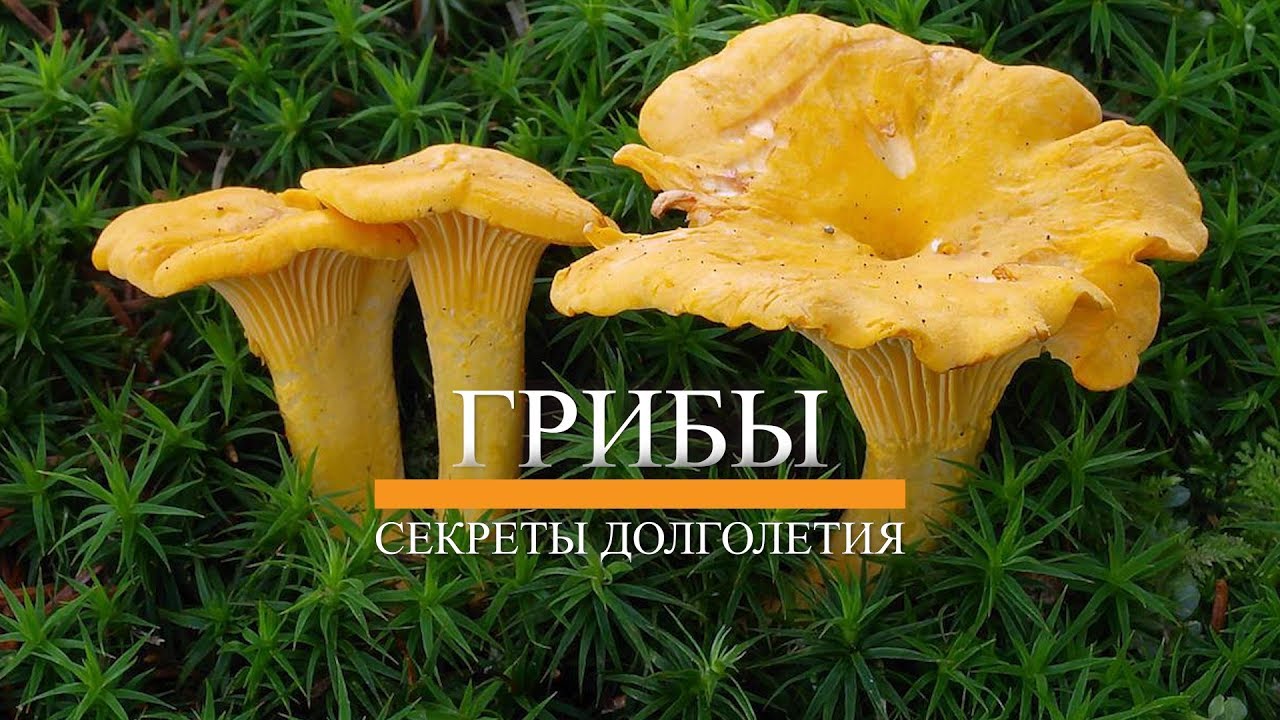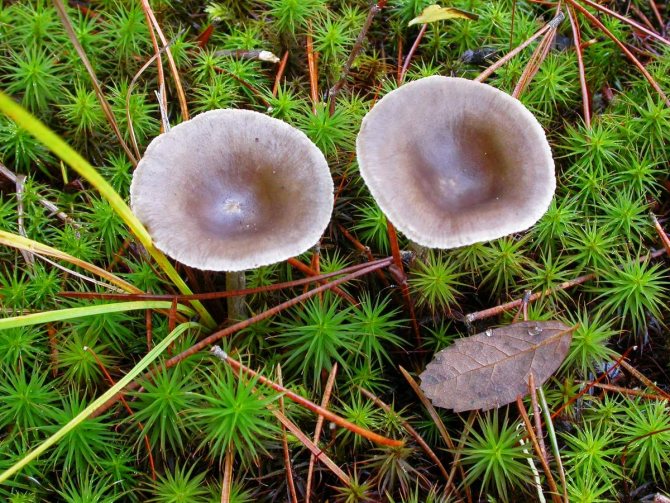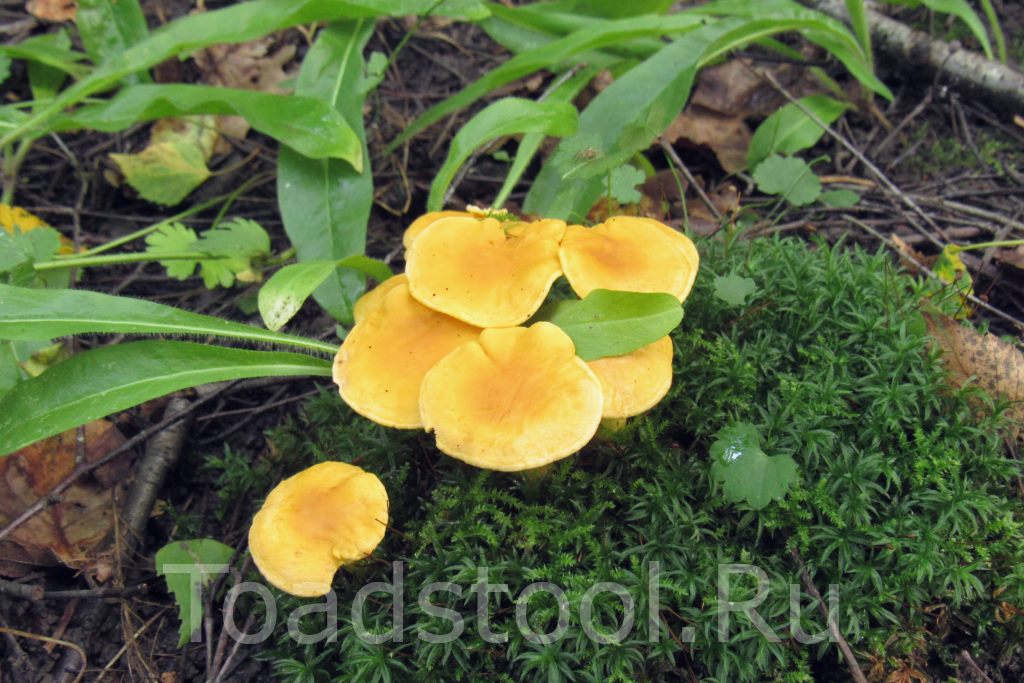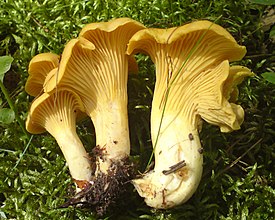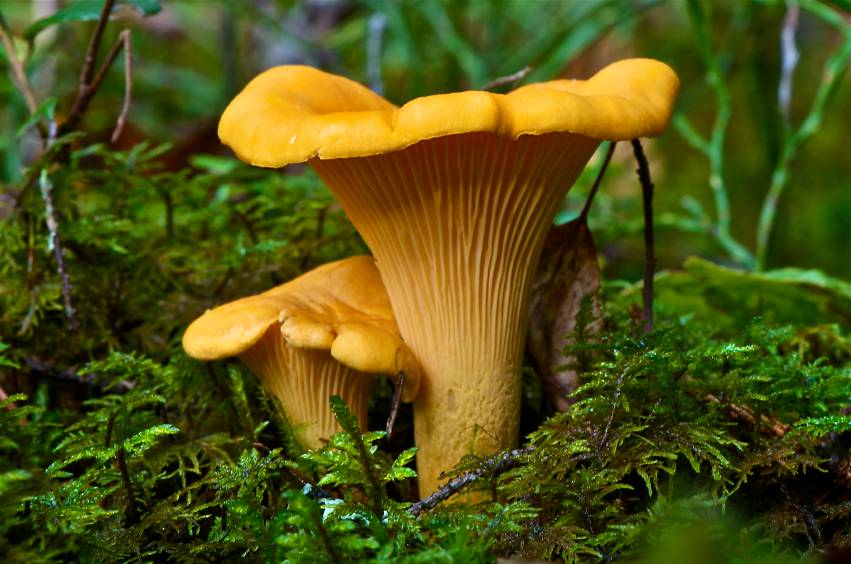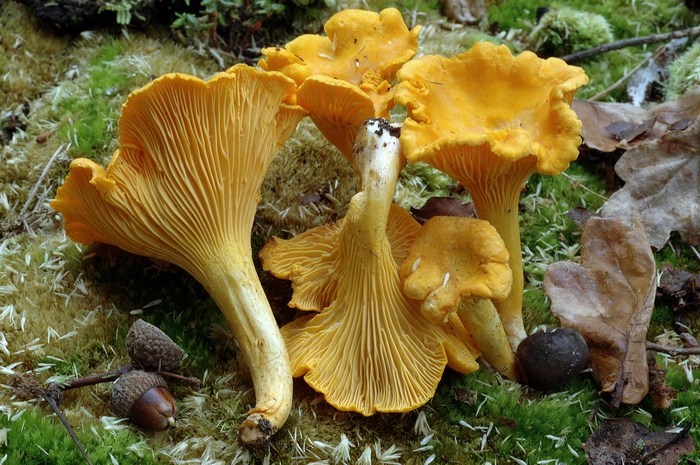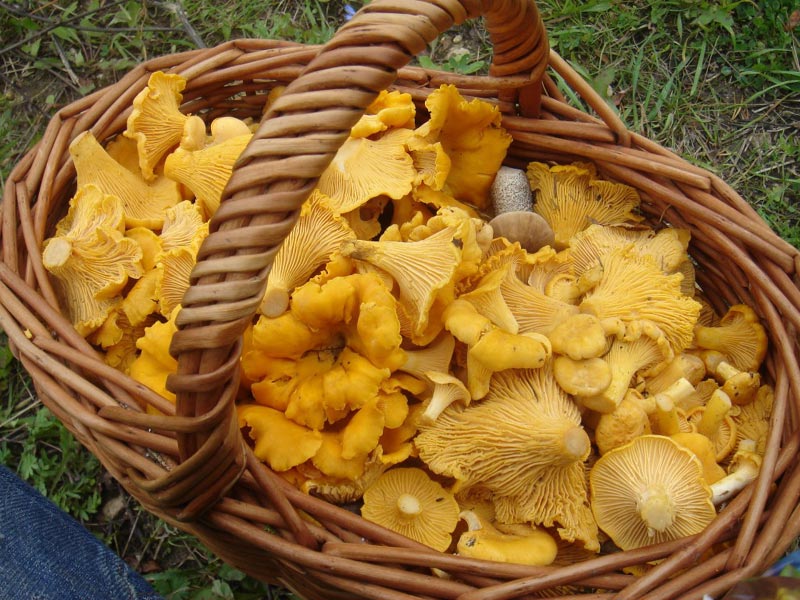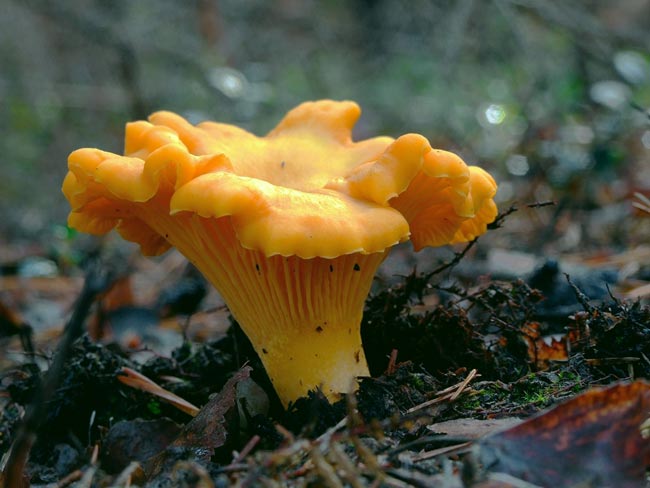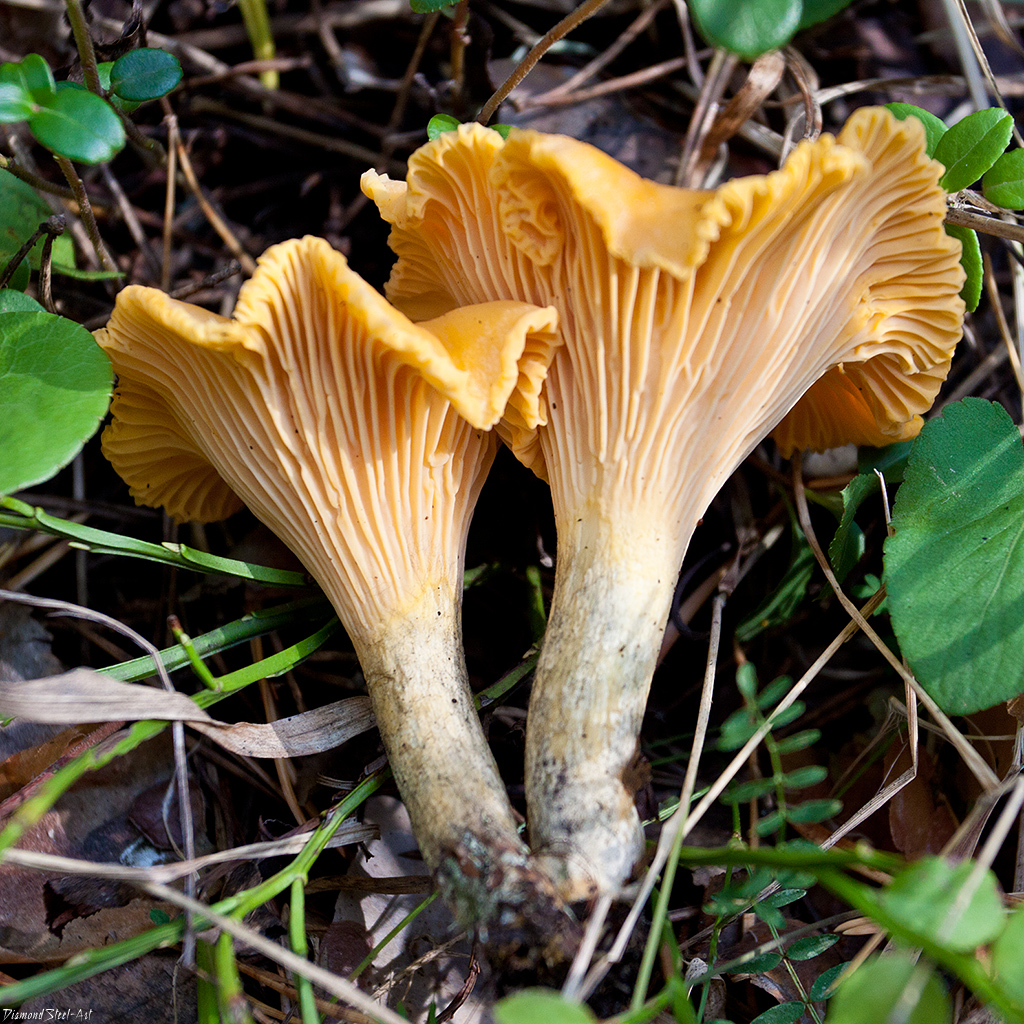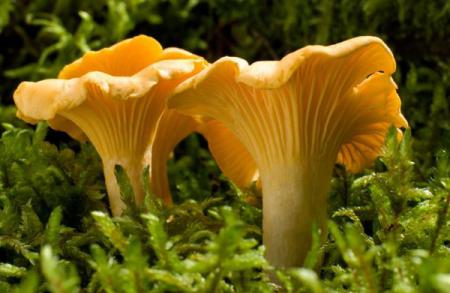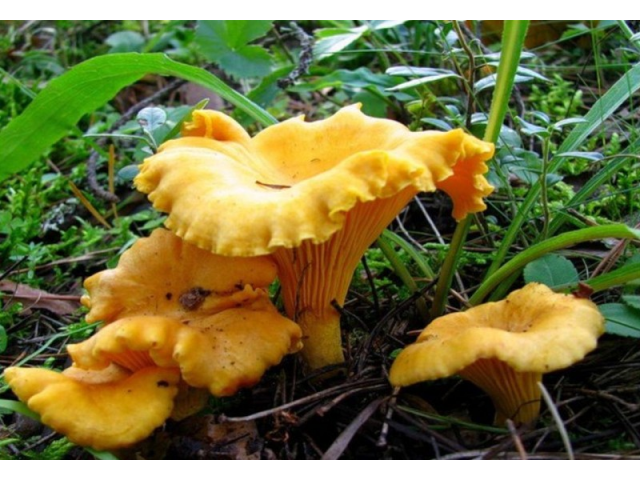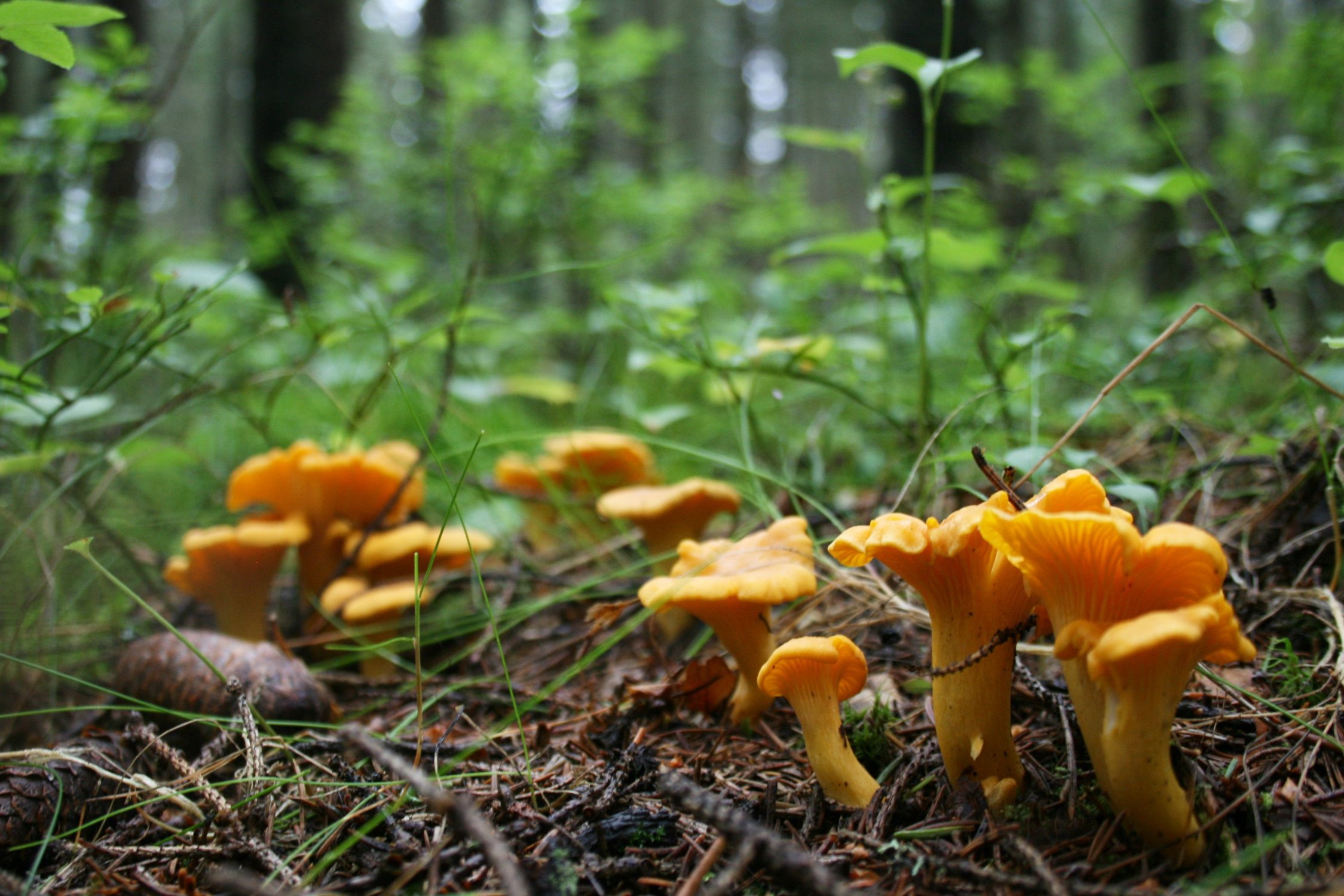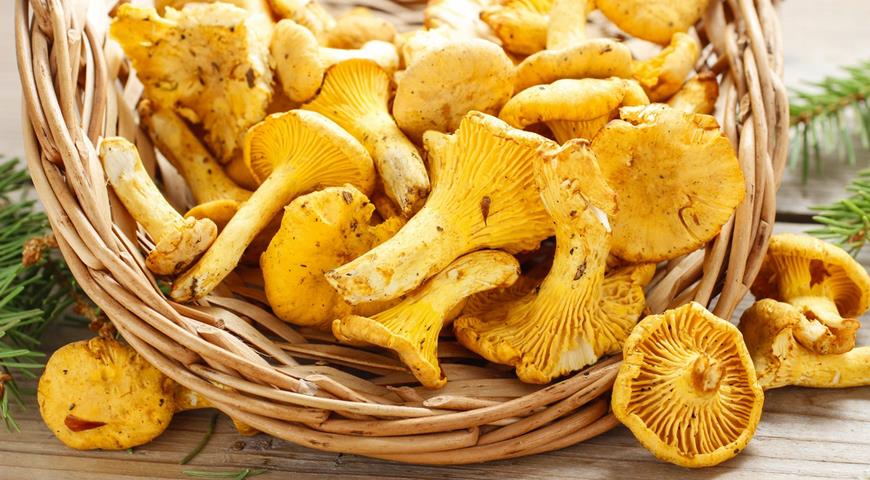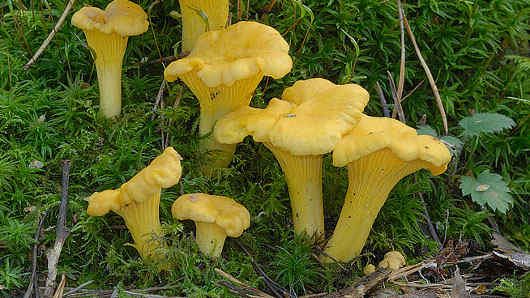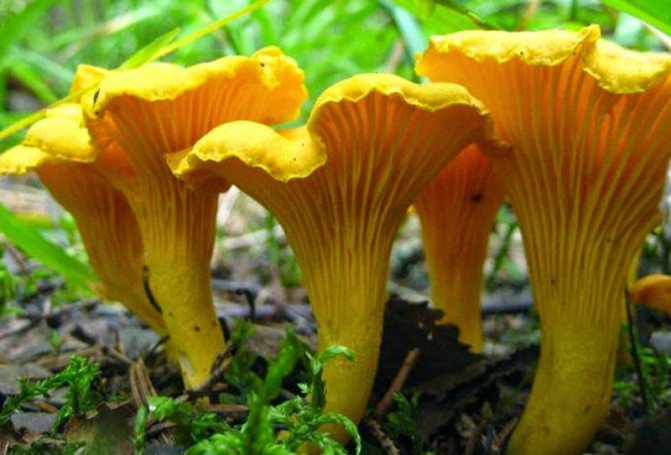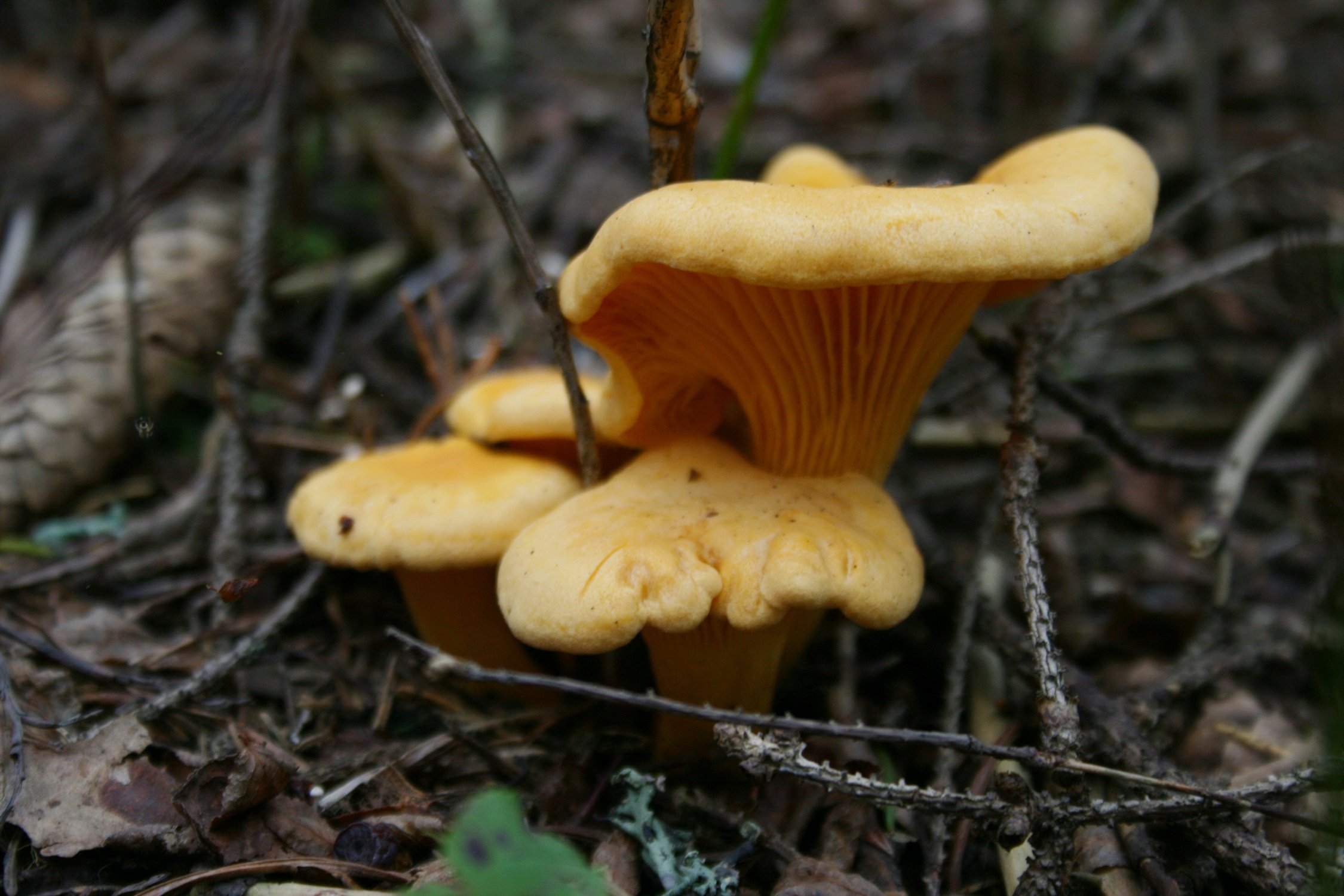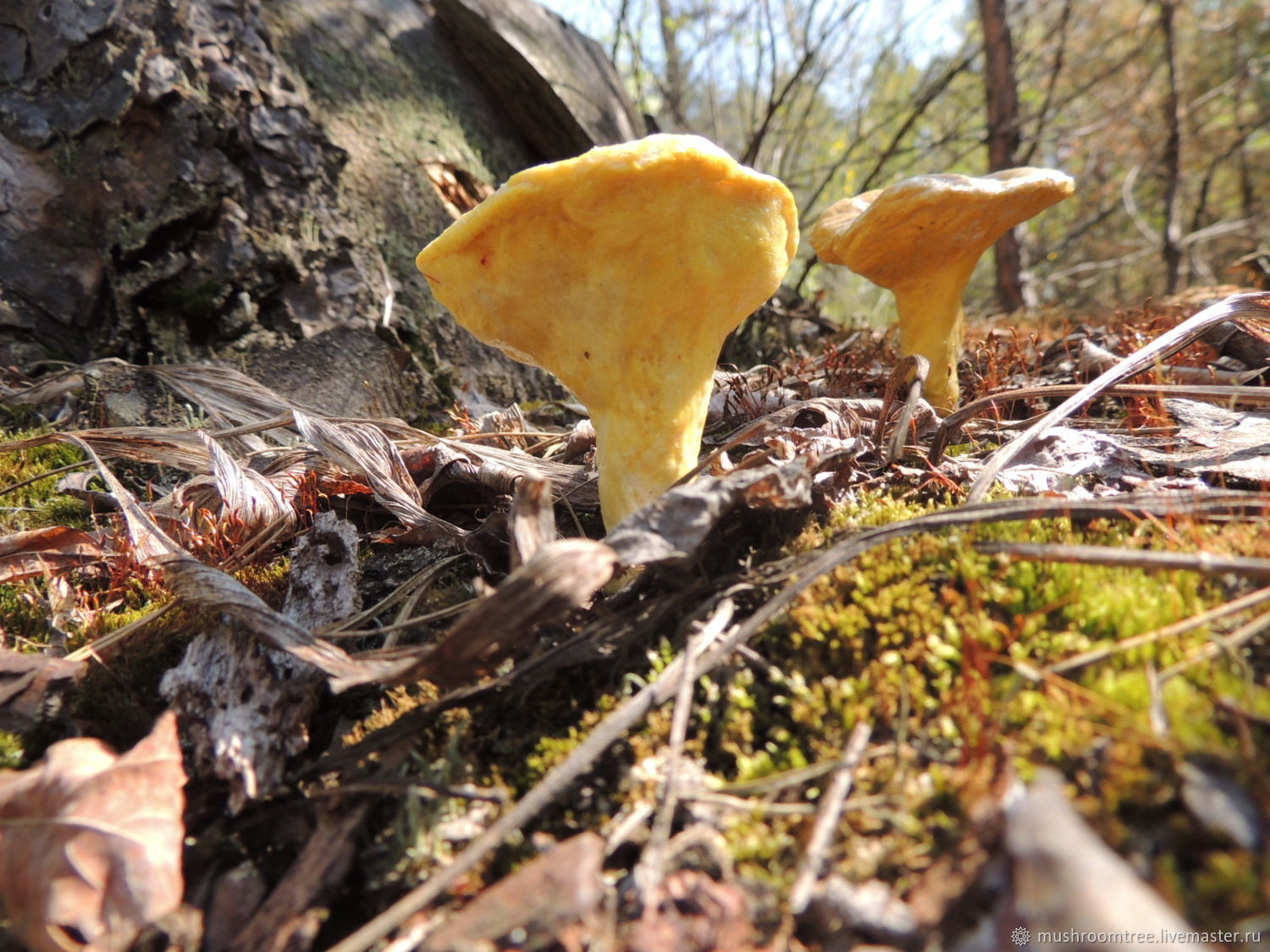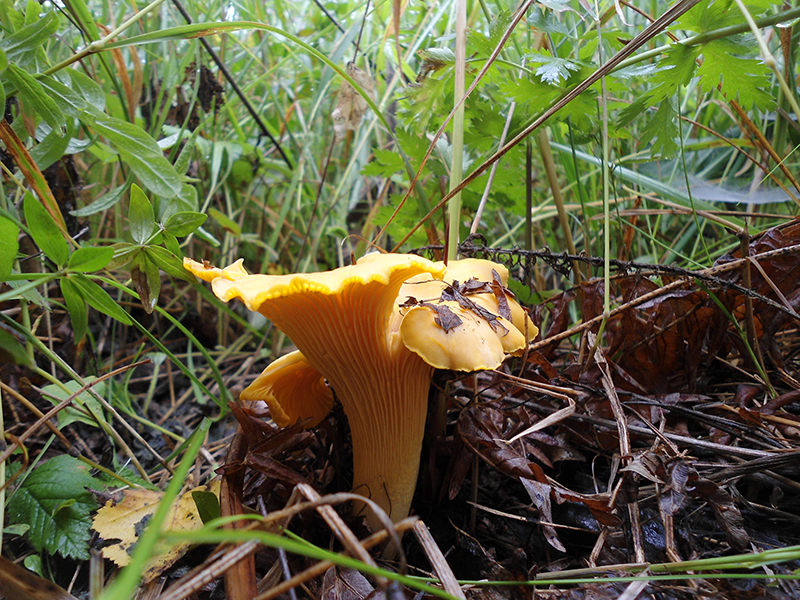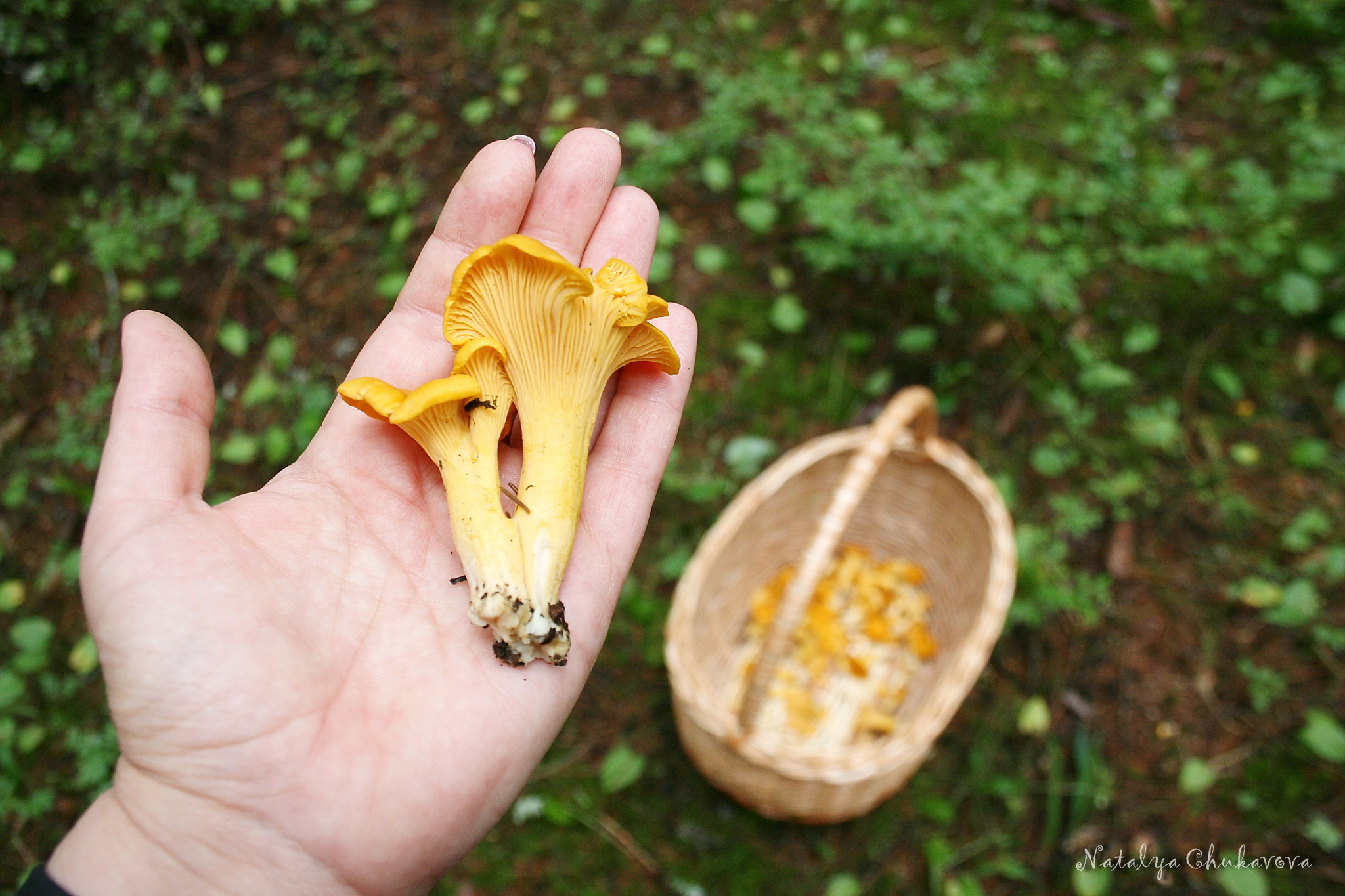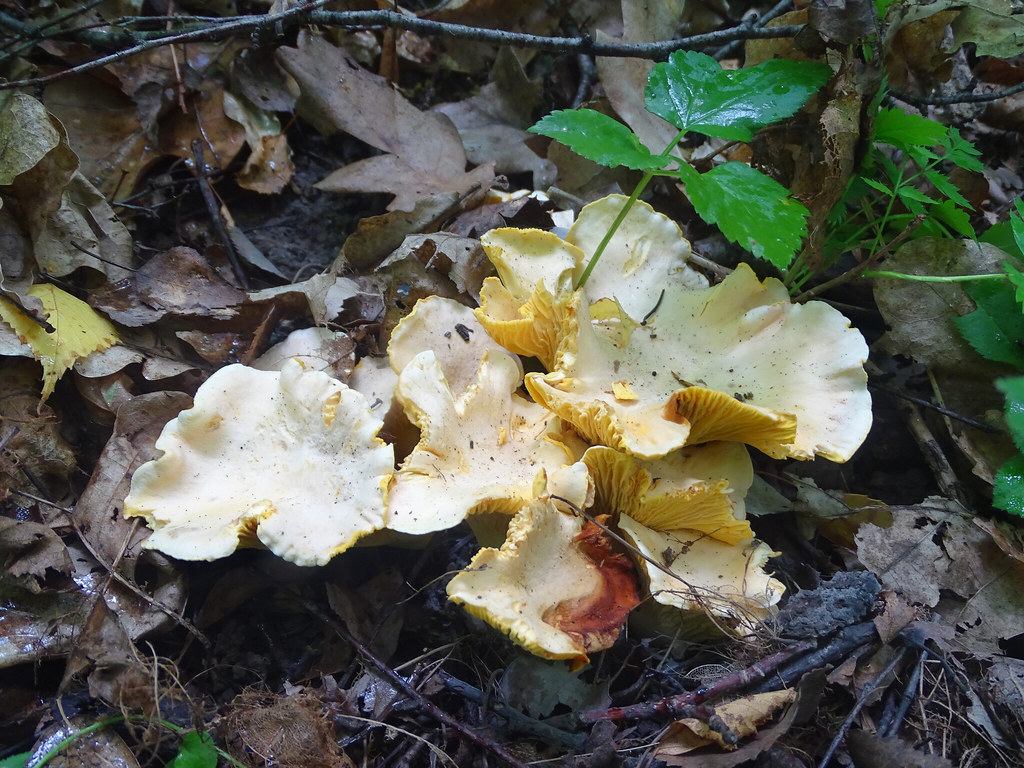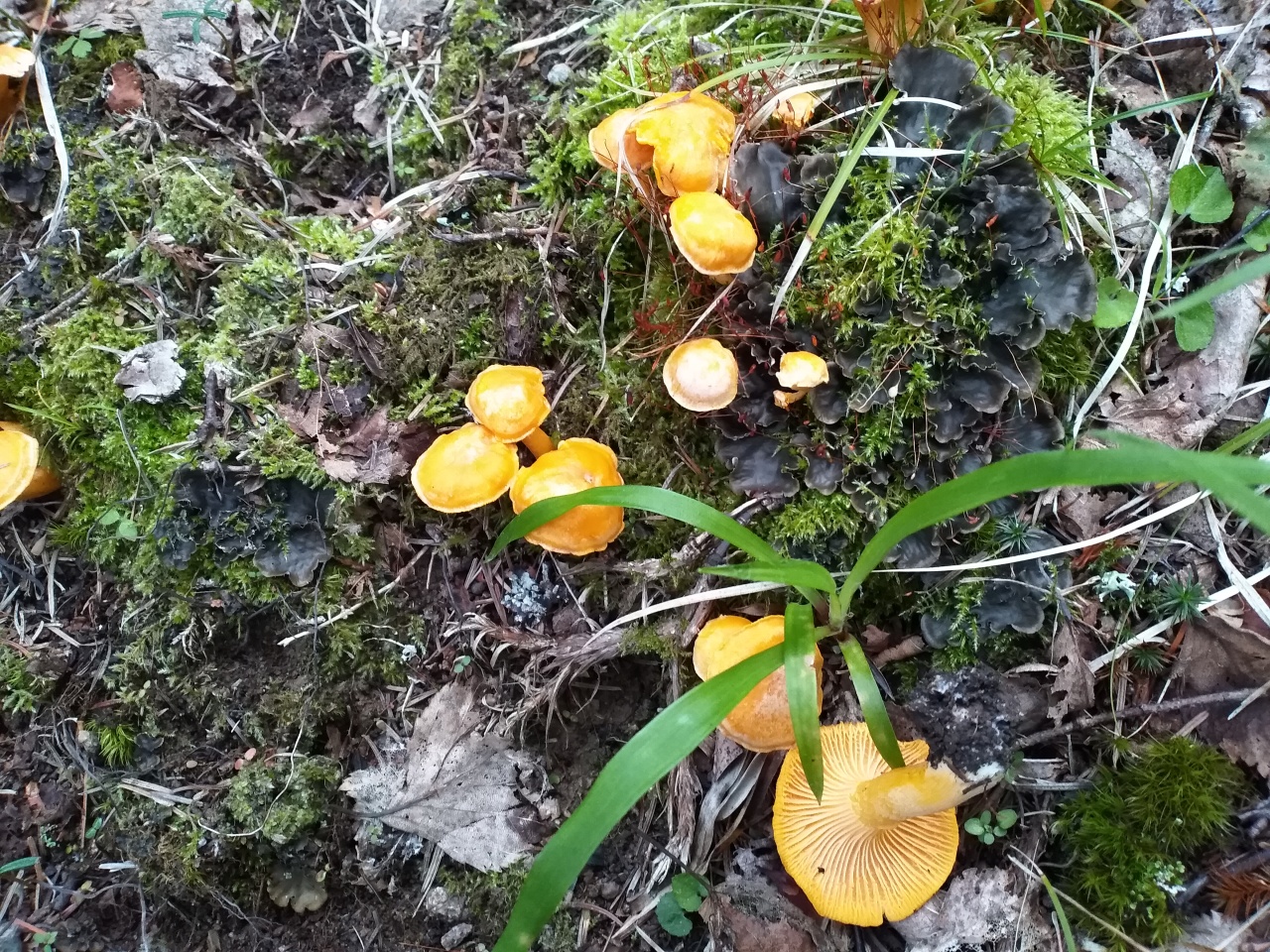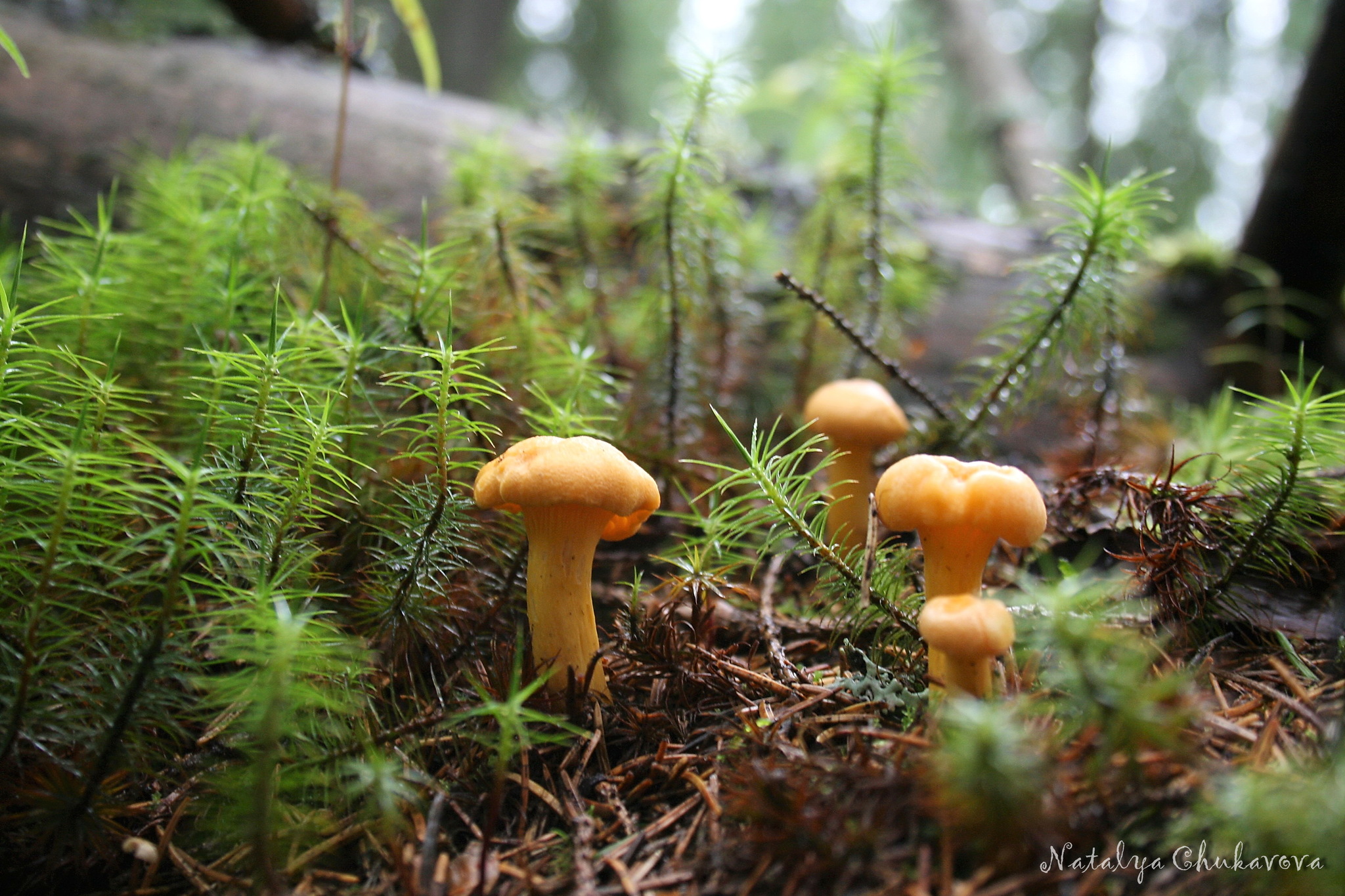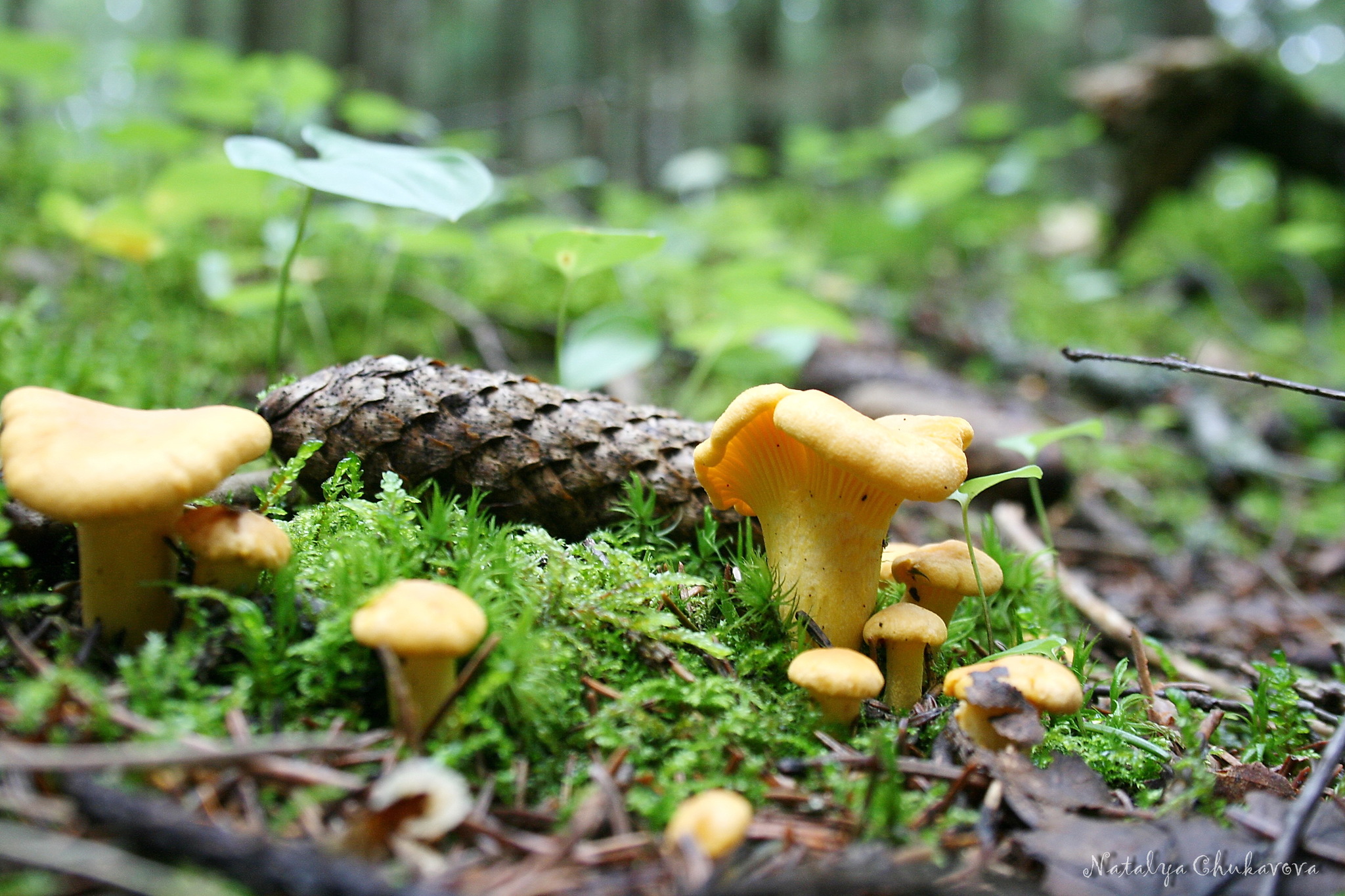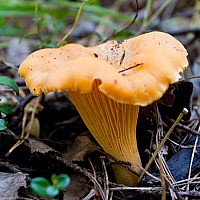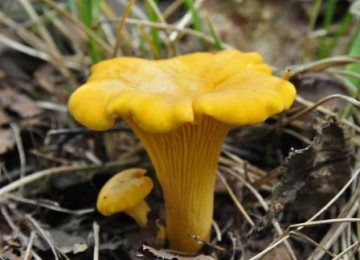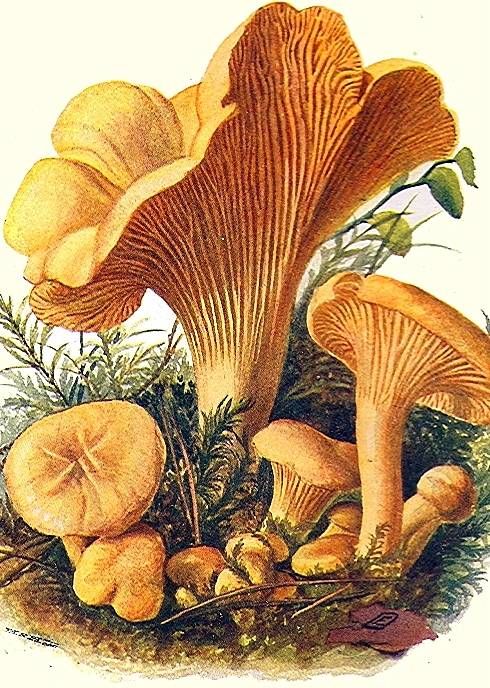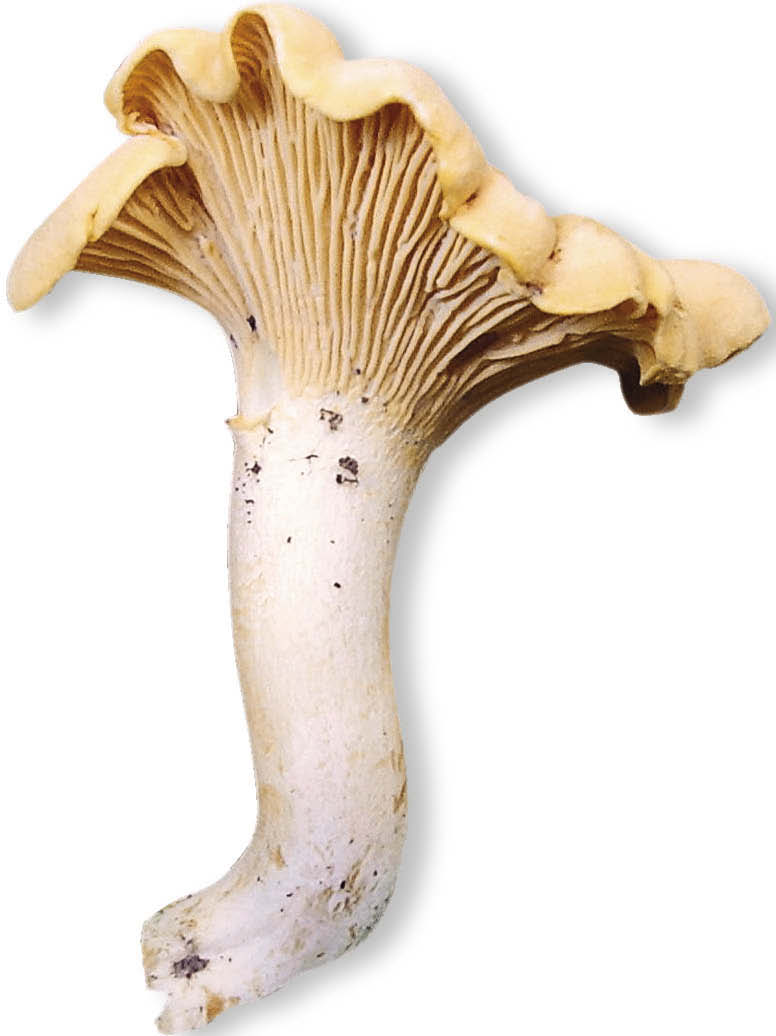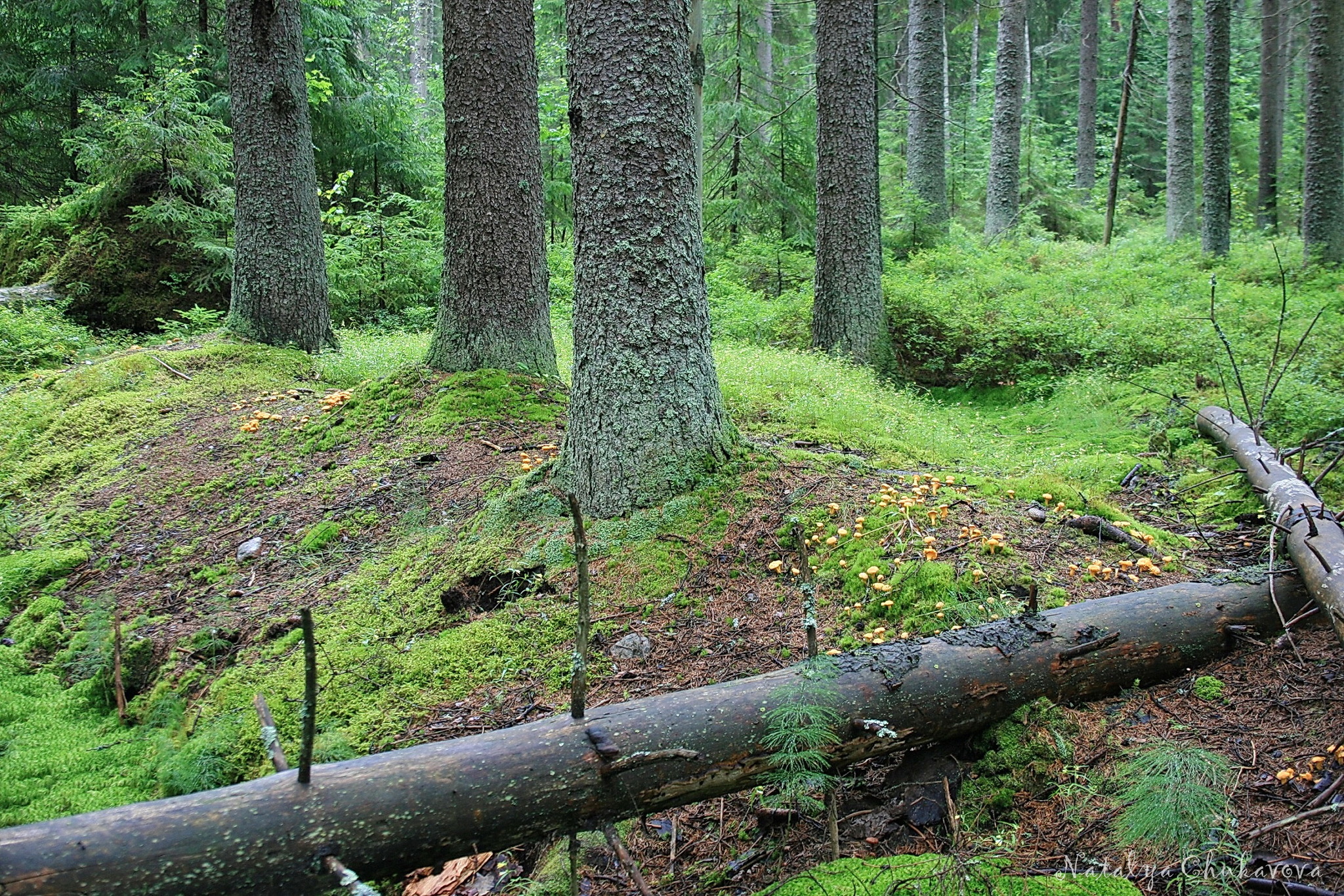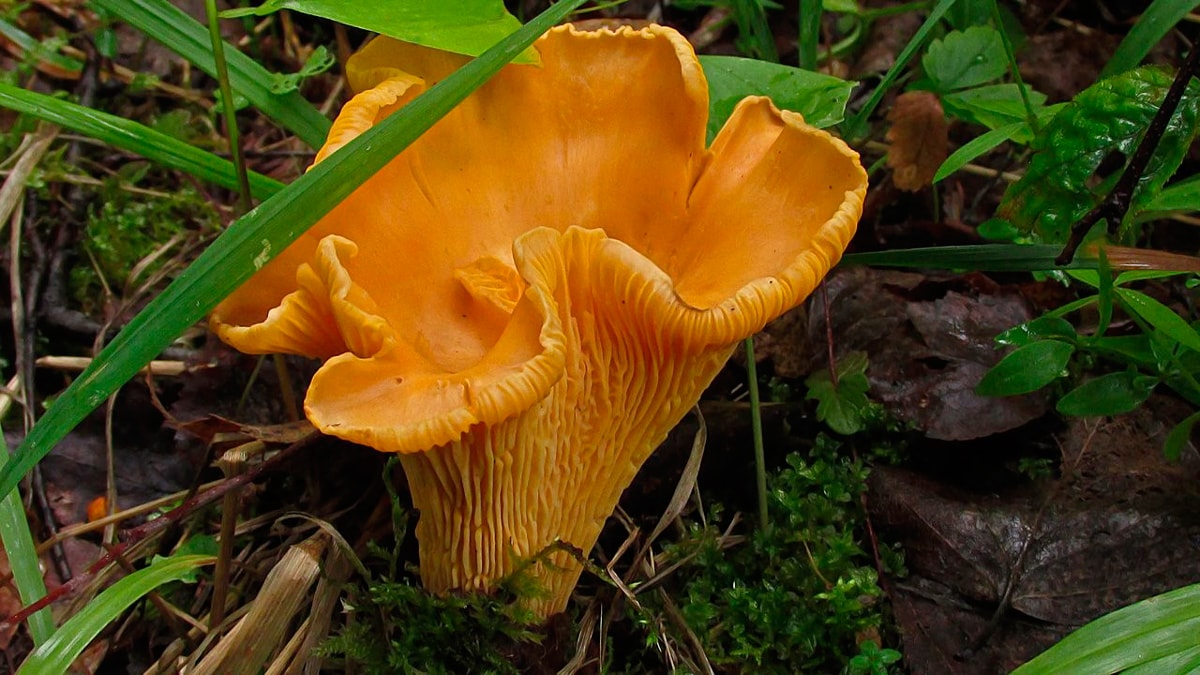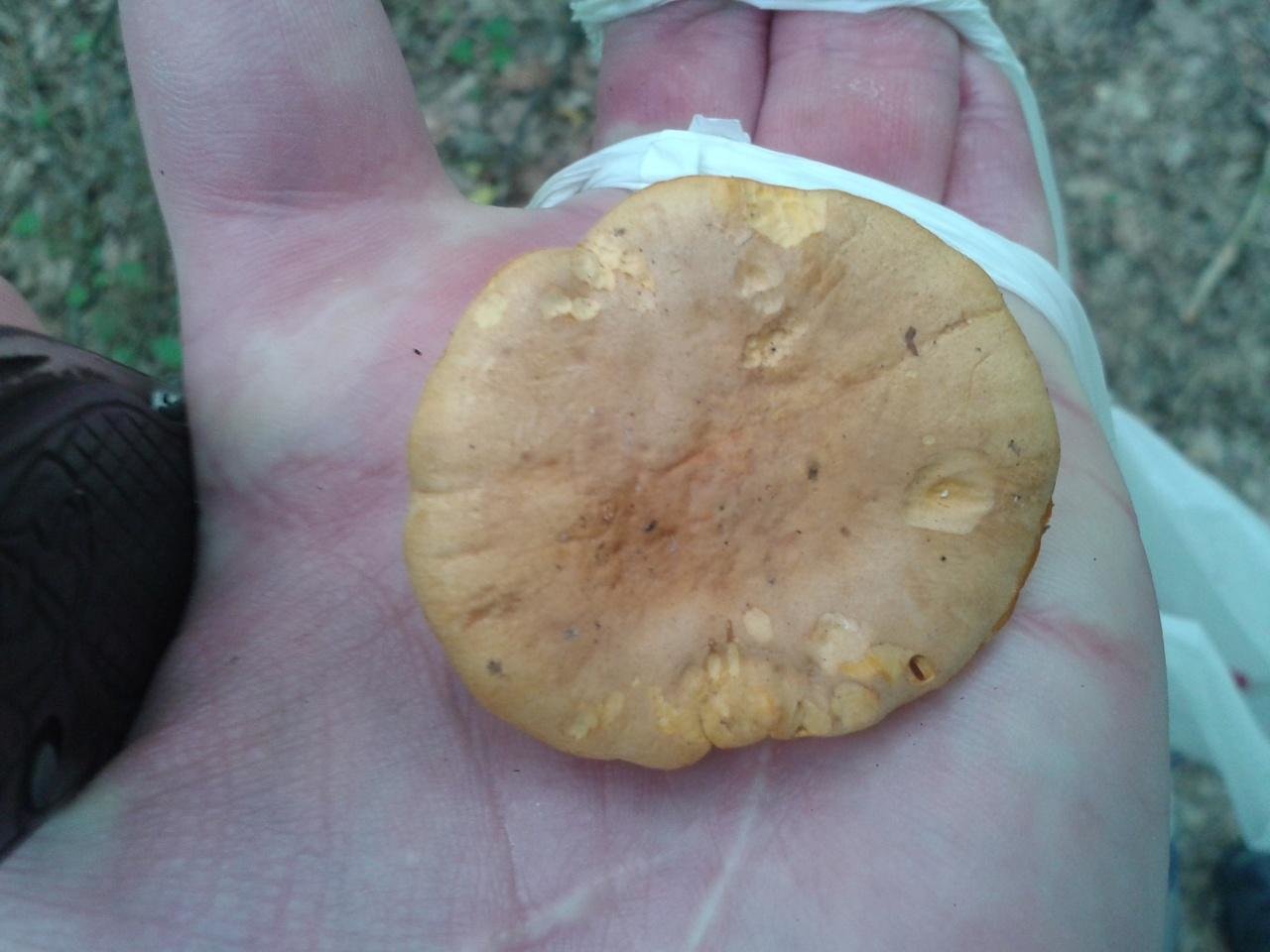Tubular chanterelle: what does it look like, where does it grow?
I first noticed the tubular chanterelle in mid-September. It was a coniferous-deciduous forest (spruce, pine, birch, aspen)
Here I collect many mushrooms - there are yellow milk mushrooms, boletus and aspen mushrooms, yellow chanterelles. And on birches in the first half of September, autumn mushroom grows massively.
When viewed from above, the tubular chanterelle can even be mistaken for autumn mushrooms. And what - it grows heap, hat to hat. And there are scales on the surface of the caps.
The surface of the cap is light brown, yellow, scaly. The older the fruiting body, the more it takes the shape of a funnel. The edge is uneven.
But as soon as you take the mushroom in your hands and look at the underside of the fruiting body, it becomes clear that this is no mushroom!
Chanterelle tubular from the side
But the "chanterelle breed" is clearly visible. The spore-bearing layer (hymenophore) is represented by folds running down the stalk. Only the color of these folds is not yellow, but gray. The leg is always yellow.
The unique look of the tubular chanterelle
The leg is hollow inside. Moreover, with the growth of the fruiting body, this cavity may well "come out", connecting with the outer funnel. And you get a "pipe"! Hence the name of the mushroom.
Strictly speaking, it is not entirely correct to call the parts of the chanterelle fruiting body a tubular “cap” and “leg”. After all, this mushroom, like other chanterelles, does not have a real clear division into a cap and a leg.
Mycologists attribute the tubular chanterelle not to the genus Chanterelle (Cantharellus), but to another genus of the same family - the genus Voronochnik (Craterellus). So the closest relative of the tubular chanterelle will still not be the yellow chanterelle, but the horn-shaped funnel (I already wrote about it).
The Latin name for the tubular chanterelle is Craterellus tubaeformis.
Of course, this in no way should stop the mushroom picker - all chanterelle mushrooms are edible!
But nevertheless, the tubular chanterelle, as we see, is much more similar to the "typical cap mushroom" than the funnel. It also has folds that form a spore-bearing layer.
In this fungus, the difference between the folds and the plates is even more noticeable. Let's see - folds not only branch. They often do not reach either the edge of the cap or the stem. As if "from nowhere" begin and end "nowhere" ...
The chanterelle is tubular, as a rule, somewhat smaller than the real chanterelle (yellow). In tubular chanterelles in my photos, the size of the hats is about 2 - 3 cm, and the thickness of the leg is only 3 - 4 mm. Nevertheless, most of them are already quite mature mushrooms.
Chanterelle size tubular
You can meet her, apparently, in the summer. Still, the tubular chanterelle is a mushroom mainly in autumn. It can be found in November too! I collected this mushroom in mid-October.
In just two very small areas of the forest (about 2 by 2 meters), within a few minutes I gained about a kilogram of mushrooms! After all, they, although small in size, are very, very numerous. Provided myself with a pretty decent margin!
Tubular chanterelle grows heap
How to cook tubular chanterelle?
It's very simple! We clean the mushrooms from adhering forest debris (and there is not much of it anyway), cut off the lower part of the leg that grew on the ground - and into a frying pan! You do not need to boil mushrooms. Grinding is also not necessary - the already tubular chanterelles are small.
Immediately feel the aroma of the mushroom that appears! I fried them for about 20 minutes, and that was the end of the cooking, and it turned out to be a great dish.
But without boiling, I only fried a part of the collected mushrooms. The rest was boiled for 20 minutes and put in the refrigerator. The next day I fried them too. At the same time, I did not find much difference in taste and aroma!
What I regret - I did not photograph the result. I hoped that I would dial some more ... But more has not happened yet. And now we already have winter on the doorstep. So further acquaintance with the tubular chanterelle is postponed for a year ...
The tubular chanterelle is also dried. When dried, it, like the horn-shaped funnel, becomes very fragrant.Can be used to make sauces.
But the Finns (according to rumors) use dried tubular chanterelle as follows. After crushing dried mushrooms, they often simply eat a spoonful of this powder, believing that this strengthens the immune system. It is possible that they are right.
Benefits of the tubular chanterelle as a good edible mushroom
In my opinion, the tubular chanterelle has several advantages:
- It is difficult to confuse it with some other mushroom, inedible or poisonous. The look is very peculiar!
- The tubular chanterelle is delicious!
- The tubular chanterelle can be found in the forest in late autumn, when there are almost no other ("classic") mushrooms there.
Subscribe to news? Click on the picture!
Topics Popular Today
Mushrooms are considered lower plants that feed on ready-made organic matter. They differ from other representatives of the flora in that they do not contain chlorophyll. More than 100 thousand different types of mushrooms grow on Earth. People used them for food many centuries ago. Medieval writers wrote about this in their treatises.
Mushrooms have always been considered a valuable food product. In terms of their nutritional value, chanterelles are classified as medium-quality mushrooms, as are aspen mushrooms, champignons and brown mushrooms. Most often, young mushrooms are used for food. They grow in whole families, they are satisfied with any forest, especially mixed. Mushroom pickers love chanterelles because they are never wormy, they can be worn in any container.
Each mushroom has its own characteristics by which they are recognized. The chanterelle has a yellow fleshy cap with peculiar bends (with the edges turned up). Narrow plates of the mushroom cover the entire stem and expand at the top, passing into the cap. The chanterelle is light yellow at the end, with a pleasant smell. When pressed on the pulp, a pinkish speck appears.
Cannot be eaten by people with acute diseases of the stomach and intestinal tract, with individual intolerance, as well as children under 5 years of age. When cooking chanterelle dishes, you must use a ceramic knife, as the metal oxidizes the nutrients of the mushrooms.
The chanterelles got their name for their colors. There are many fairy tales, stories and riddles about them in the literature.
-
Mixed forests
Mixed forests are a unique natural area where coniferous and deciduous trees grow, with a wide variety of admixtures of other plants.
-
Dolphins
Dolphins are extraordinary creatures. They are mammals, warm-blooded. They live in the warm salty water of the seas.
-
Ancient Egypt
The ancient Egyptian civilization was perhaps the first to appear on the territory of the African continent. The Egyptians themselves called their country Kemi and considered it "the breadbasket of the world."
-
Tale of Bygone Years
This chronicle is an early source describing the history of Russia. Here is information about the Middle Ages. It is this story that helps modern scientists to restore events
-
Medicine
Only thanks to the development of medicine, many people are now among the living. If we consider the medicine of ancient times, it becomes very sad. The medicine was at a horribly low level.
-
Smolensk
For the first time Smolensk was mentioned in the chronicle (The Tale of Bygone Years) in 862 as the main city of the Krivichi tribal union. From that time to the present, it has been the center of various battles.
Description of false chanterelle
The false chanterelle has a brighter color in comparison with the real chanterelle. Its color is most often orange with a brown tint, the edges are always lighter than the center. The surface of the cap is velvet. The color of the cap of a real chanterelle is light yellow, sometimes it can be almost white, but it can reach yellow-orange. A real chanterelle can never be as red as its counterpart. In addition, the color is the same both in the central part and at the edges, and the surface is smooth.
The edges of the caps of the false chanterelles are smooth, neatly rounded. The diameter of the cap does not exceed 3-6 centimeters. In young mushrooms, the shape of the cap is slightly convex, while in mature it becomes funnel-shaped. The edges of the caps of real chanterelles are wavy, their shape is irregular.The diameter of the cap can be up to 12 centimeters. In young true chanterelles, the cap is convex in shape, then becomes flat.
The plates of false chanterelles are thin, often located, not passing to the stem, branching, orange in color. And in real chanterelles, the plates are denser, they go down to the leg.
The flesh of false chanterelles is yellow, friable, tasteless with an unpleasant odor. If you press on the pulp, its color remains the same. In real chanterelles, the flesh is white in the middle, and yellowish at the edges, its taste is sour and has a pleasant aroma.
False chanterelles have thin, red-orange legs. In adult specimens, the legs are hollow. In the lower part, the color of the leg is darker. The shape is cylindrical. The cap is clearly separated from the leg. In real chanterelles, the legs are not hollow, they are thicker, there is no distinction with the cap, dense, smooth, narrowed downwards, of the same color as the cap. In false chanterelles, the color of the spores is white, while in the real ones it is yellow.
Where do false chanterelles grow?
These mushrooms can be found in mixed and coniferous forests. They are found on decaying wood, in moss, among dead wood. Yields peak from summer to autumn. False chanterelles can grow singly and in groups. Real chanterelles also grow in forests, but they do not inhabit old trees.
False chanterelles often grow in the neighborhood of real chanterelles. Another difference between these similar mushrooms is that worms never start in real chanterelles, which is due to the content of chitinmannose in their composition. This substance has an anthelmintic effect. Insect larvae die under the influence of this substance. In false chanterelles, chitinmannosis is not produced, so their fruiting bodies can be affected by worms.
Are False Chanterelles Poisonous or Not?
False chanterelles can be eaten, but they are not particularly tasty mushrooms. Like other conditionally edible mushrooms, false chanterelles need preliminary soaking for 3 days. In this case, in the morning and in the evening, the water must be replaced with a new one. After soaking, the mushrooms are boiled for 15 minutes. The false chanterelles can then be marinated or fried.
As a rule, experienced mushroom pickers do not pay attention to false faces, since more delicious mushrooms grow in the forest at this time. It should be remembered that in people with a weak digestive system, the use of false chanterelles can provoke a violation of the digestive process
With improper culinary processing of false chanterelles, signs of poisoning appear: nausea, dizziness, vomiting, weakness, upset stools, abdominal pain and cramps. With these symptoms, you should immediately call an ambulance.
New biological activity of the polysaccharide fraction of Cantharellus cibarius and its structural characteristics.
One of the most commonly consumed mushrooms in Europe is Cantharellus cibarius, also known as chanterelles. Research has been carried out on the beneficial properties of crude polysaccharides of this kind. The results show that the polysaccharide fraction from C. cibarius inhibits the activity of both COX-1 and COX-2. Moreover, prebiotic potential has been identified for Lactobacillus strains. The crude polysaccharides have been found to inhibit the proliferation of colon cancer cells while not being toxic to normal cells. The purification and structural characterization of the investigated polysaccharide fraction from C. cibarius indicates that it consists of one monosaccharide in a repeating unit → 6) -α-D-Manp- (1 →. The presented activities indicate for the first time that the fungus has an interesting chemopreventive potential, especially against colon cancer.
Literature
- Gorlenko M.V., Bondartseva M.A., Garibova L.V., Sidorova I.I., Sizova T.P. Mushrooms of the USSR / Otv. ed. M.V. Gorlenko. - M.: Thought, 1980 .-- 304, p. - (Reference guides-identifiers of a geographer and a traveler). - 100,000 copies
- Dodik, S. D. Mushrooms of Russian forests. - M.: AST, 1999 .-- 320 p.
- Mushrooms: Handbook / Per. with it. F. Dvin. - M.: Astrel, AST, 2001 .-- S. 228 .-- 304 p.- ISBN 5-17-009961-4.
- Grunert G. Mushrooms / per. with him. - M.: "Astrel", "AST", 2001. - S. 192. - (Guide to nature). - ISBN 5-17-006175-7.
- Lesso T. Mushrooms, determinant / per. from English L. V. Garibova, S. N. Lekomtseva. - M.: "Astrel", "AST", 2003. - S. 28. - ISBN 5-17-020333-0.
- Udu J. Mushrooms. Encyclopedia = Le grand livre des Champignons / per. with fr. - M.: "Astrel", "AST", 2003. - S. 35. - ISBN 5-271-05827-1.
Common chanterelle, Cantharellus cibarius
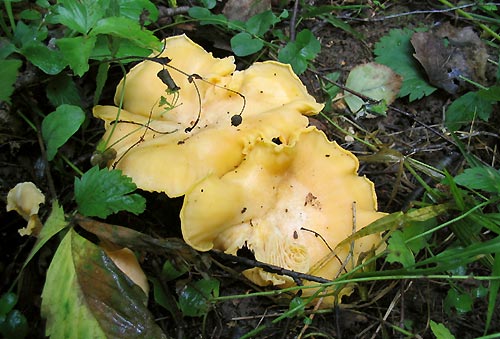
Hat: Egg or orange-yellow color (sometimes fading to very light, almost white); in outline, the cap is initially slightly convex, almost flat, then funnel-shaped, often of irregular shape. Diameter 4-6 cm (up to 10), the cap itself is fleshy, smooth, with a wavy folded edge. The flesh is firm, firm, cap color or lighter, with a weak fruity odor and slightly pungent taste.
Spore-bearing layer: Represents folded pseudo-plates, running down the stalk, thick, sparse, branched, of the same color with the cap.
Spore powder: Yellow.
Leg: The same color as the cap, fused with it, solid, dense, smooth, narrowed to the bottom, 1-3 cm thick and 4-7 cm long.
Distribution: This very common mushroom grows from early summer to late autumn in mixed, deciduous and coniferous forests, at times (especially in July) in huge numbers. It is especially common in mosses and coniferous forests.
Similar species: Hygrophoropsis aurantiaca, or False Chanterelle, is vaguely similar to the common chanterelle. This mushroom is not related to Cantharellus cibarius, belonging to the Paxillaceae family. The chanterelle differs from it, firstly, in the deliberate shape of the fruiting body (after all, a different order is a different order), an inseparable cap and a leg, a folded spore-bearing layer, an elastic rubbery pulp. If this is not enough for you, then remember that Hygrophoropsis aurantiaca has an orange cap, not yellow, and the stem is hollow, not solid. But only an extremely inattentive person can confuse these types.
The common chanterelle also resembles (to some inattentive mushroom pickers) the yellow hedgehog, or Hydnum repandum .. But to distinguish one from the other, you just need to look under the hat. In the hedgehog, the spore-bearing layer consists of many small easily detachable spines.
However, it is not so important for a simple mushroom picker to distinguish a hedgehog from a chanterelle: in the culinary sense, in my opinion, they are indistinguishable
Edible: Indisputable.
Author's notes: It’s just a feeling of contradiction that I don’t want to admire the chanterelle here. In addition, the Germans love her, and this in itself cannot but cause a special kind of thoughts. After all, as we know from books and films, what is the main thing for a German? Uniformity. The chanterelle mushroom provides enough uniformity to cover an entire German TV show. Judge for yourself: 1) The chanterelle mushroom is never a worm (well, except in special cases). 2) The chanterelle mushroom rots very neatly - clearly changing color and consistency at the point of decay; you can always say - it is rotten to this day, but no further. 3) The chanterelle mushroom has no internal structure - it is completely uniform within its own limits! The chanterelle mushroom walks in formation and sings "Horst Wessel". Or not. In the spirit of the times, the chanterelle mushroom walks in formation and fights against fascism. Because there is discipline.
However, not everything is so boring. There is also an alternative, white chanterelle. Somewhere long ago I saw that it was singled out as a separate species, but where? This is not the case in the literature I now use. Well, God bless them. The main thing is that we know that in deciduous forests, on the edges, in the grass, a mushroom grows in a format indistinguishable from a chanterelle, but white, denser and more accurate. And this is good, because on the contrary, uniformity is very, very bad.
On the other hand, I know an easy way to turn a white chanterelle into a yellow one. You just need to put it in water and leave it there for several hours. After doing this simple experiment, you will be greatly surprised.
Similar species
Edible:
- Chanterelle velvety (Cantharellus friesii) - a brighter orange color, common in Europe and Asia.
- Faceted chanterelle (Cantharellus lateritius) - with a less developed, almost smooth hymenophore and more brittle pulp, widespread in North America, Africa, the Himalayas (especially in the Almora hills) and Malaysia.
- Hericium yellow - the hymenophore of this fungus looks more like papillae or spines, rather than plates.
Inedible and poisonous:
- False chanterelle (Hygrophoropsis aurantiaca) - with thin soft pulp and frequent blades, it grows not on the soil, but on the forest floor, on rotting wood. Found throughout the Northern Hemisphere. Contradictory data on toxicity.
- Omphalot olive (Omphalotus olearius) Is a poisonous mushroom common in the subtropics (Mediterranean). It grows on dying deciduous trees, especially olives and oaks.
Chanterelles
Herbal flakes
| Latin name: | Cantharēllus cibārius |
| English name: | Chanterelle |
| Domain: | Eukaryotes |
| Kingdom: | Mushrooms |
| Department: | Basidiomycetes |
| Class: | Agaricomycetes |
| Order: | Chanterelles |
| Family: | Chanterelles |
| Genus: | Chanterelle |
| Edibility | Edible mushroom |
general information
The mushrooms got their name because of their characteristic reddish-yellow color. This color is promoted by the high content of vitamin C.
There are edible and poisonous species of chanterelles. False representatives of this group of fungi grow on rotting trees, most often found in swamps and near lakes. Edible chanterelles most often grow in coniferous and mixed forests.
This group of fungi belongs to the chanterelle family, the agaricomycete class.
Mushroom dimensions
The mushroom is small in size, with a long, thick stem. The average diameter of the cap is 10 cm, the leg reaches 10-13 cm in length and 1-2 cm in width.
Hat
Chanterelles have a flat-shaped yellow-orange cap. It is wavy at the edges and curled towards the center. If you look at the hat from above, you can see that it is irregular in shape. The top of the chanterelle can be 1 to 10 cm in diameter. It has a tubular structure.
Pulp
The flesh of chanterelles is dense, white. There are fibrous and fleshy. When pressed, it changes color to red. The aroma resembles the smell of dried fruit, and the taste is sour.
Leg
Chanterelle leg is usually thick and long. It can be up to 15 centimeters long. It does not have a skirt and a ring and, more often than not, simply grows together with the top. The color is orange-yellow, more saturated at the top. The cap expands from bottom to top and has small scales at the bottom.
Where do chanterelles grow?
The chanterelle prefers to grow in mixed and coniferous forests. It can be found in areas where moss and long plants grow. The season for collecting chanterelles is mid-summer - late autumn.
For a good harvest, chanterelles need a lot of moisture and nutrients, which enter their body through moss and wood.
In deciduous forests, this type of mushroom feels uncomfortable. Sunlight does not penetrate well under a large layer of opal foliage, which is why the mushrooms begin to dry out and lose their attractive appearance.
Coniferous and mixed forests are the optimal habitat for chanterelles. In the soil under pine and spruce there are many trace elements that contribute to the development of mycelium. It is in such places that the root of the fungus can produce several fruits in one season.
Chanterelles are found all over the world, with the exception of the Permafrost and Desert zone.
When do chanterelles appear?
The optimal time for the growth of chanterelles is July-September. Mycelium begins to bear fruit best in August after a warm summer rain. This group of mushrooms does not tolerate the cold, therefore it does not grow in winter.
In addition, chanterelles do not like the sultry sun, so they slow down their growth in spring and early summer. The same stop in the development of the mycelium occurs after each summer rain - the fungus tries to retain moisture in itself for a long period of time. The fruit resumes its development on the third to fifth day after watering.
Edibility
There are both edible and inedible species of chanterelles. The chanterelle has a pleasant smell and delicate shade, while the false mushroom smells like fish or vinegar.
The main differences between edible and inedible chanterelles are:
- Hat color. Inedible chanterelles are bright orange, and edible chanterelles are yellow.
- Hat shape. Inedible mushrooms have a clear circle shape.
- Leg. A real mushroom has a thick stem, and an inedible one has a thin one.
- Smell. Inedible chanterelles have a vinegar smell.
- Habitat.Inedible chanterelles grow on fallen trees in deciduous forests, real ones in mixed or conifers.
- Pulp. Edible chanterelles have yellow flesh, white in the center. Fake mushrooms have orange flesh.
If the mushrooms are real, then they can be fried, boiled or baked. Chanterelles make good casseroles, pies, zrazy and soups. All these dishes will not take more than an hour to cook. Chanterelles can also be salted, pickled or dried, but this will take more time.
There are many types of chanterelles. You need to be able to distinguish between edible and inedible representatives.
The chanterelle is real
This type of mushroom is found in deciduous and coniferous forests. It can be found from early summer to mid-autumn. A feature of the mushroom is its bright yellow color.
The chanterelle's cap has a dimple in the center and curled edges. Yellow color. The diameter can reach 10 cm. The leg is attached to the cap in one layer and does not have a skirt. Its dimensions are 3-10 cm, and its shape is cylindrical. The pulp is dense, it is difficult to damage it to larvae and flies. Chanterelle spore powder is yellow.
Description
Fruiting bodies are similar in shape to caps, but the cap and stem are a single whole, without a pronounced border; color - from light yellow to orange-yellow.
The cap is 2–12 cm in diameter, often with a wavy edge or irregular shape, concave-spread, convex, then depressed, flat, with curled edges and depressed in the center, in mature mushrooms up to funnel-shaped. The surface of the cap is smooth, matte. The skin is difficult to separate from the pulp of the cap.
The pulp is dense-fleshy, fibrous in the stem, yellow at the edges and whitish in the middle of the fruiting body, with a sour taste and a faint smell of dried fruits or roots. When pressed, it turns slightly red.
A leg fused with a cap and of the same color or lighter, solid, dense, smooth, tapering downwards, 1 to 3 cm thick and 4 to 7 cm long.
folded (pseudo-lamellar), consists of wavy, often highly branched folds, strongly descending along the leg. The hymenophore can also be veined, coarse-celled; veins are thick, sparse (less than 10 pcs / cm), low, fold-like, forked or not, forked-branched, far descending to the stem (belongs to aphilophoral fungi).
Light yellow spore powder, ellipsoidal spores, 8.5 × 5 microns.
A distinctive feature of the common chanterelle is the almost complete absence of wormholes and insect larvae in the pulp. In the spores and pulp of the common chanterelle there is chinomannosis, which has a detrimental effect on arthropods and helminths of all types. Quinomannose envelops the capsules of the eggs of the parasites, dissolves them and destroys the contents.
Variability
The known form Cantharellus cibarius var. amethysteus, lighter and smaller, with dense purple scales on the surface of the cap. Distributed in beech and mixed with beech forests.
Chanterelles are real and humpbacked
Chanterelle is a widespread edible mushroom with a high yield. It grows in numerous groups, forming so-called witch circles or wide stripes, from mid-July to mid-October, with the peak of fruiting in July-August. It is necessary to look for it in damp open areas of coniferous or deciduous forest.
The plates are folded, descending far to the pedicle, branched, thick, sparse. The leg expands smoothly upward, without a distinguishable border turning into a cap, dense, yellow, smooth, up to 7 cm in length and 3 cm in thickness, cylindrical, solid.
The pulp is thick, fleshy, brittle, with a pleasant mushroom smell, almost never wormy.
Goes to canning blanks. Used without pretreatment, boiled and fried. For the future, it is harvested in the form of boiled canned food (in cans), and can also be marinated and salted (hot).

The main characteristic of the chanterelle mushroom is real - a high content of carotene, much higher than in all other well-known mushrooms.Besides carotene, this mushroom contains many other vitamins and has antibacterial properties. In some countries, the chanterelle is used to prevent cancer.
Humpbacked chanterelle, or cantarellula, is a rather rare edible lamellar mushroom on the territory of Russia, which gives consistently high yields annually. It grows in small groups from mid-August to September, but yields especially bountiful harvests at the very beginning of autumn. In which forests do chanterelle mushrooms of this species grow? You need to look for them in areas of coniferous forest overgrown with a thick layer of moss, best of all in a pine forest.
The cap of the mushroom is initially convex, but gradually takes the form of a wide funnel with a diameter of about 4 cm, with a slight bulge in the middle. Its surface is painted in a lustrous gray with a smoky tint and concentric brown circles. The spore-bearing layer consists of frequent grayish plates descending to the pedicle.
The humpbacked chanterelle belongs to the fourth category of mushrooms. It is eaten boiled or fried.

Below you can familiarize yourself with a brief description of yellowing and gray chanterelle mushrooms.
Orange talker (Hygrophoropsis aurantiaca)
- Other names for the mushroom:
- False fox
- Kokoschka
Synonyms:
- Gigroforopsis orange
- Kokoschka
- Agaricus aurantiacus
- Merulius aurantiacus
- Cantharellus aurantiacus
- Clitocybe aurantiaca
- Agaricus alectorolophoides
- Agaricus subcantharellus
- Cantharellus brachypodus
- Cantharellus ravenelii
- Merulius brachypodes
Description
Hat: 2-5 centimeters in diameter, under good conditions - up to 10 centimeters, first convex, with a bent or strongly bent edge, then flat-spread, depressed, funnel-shaped with age, with a bent thin edge, often wavy. The surface is finely velvety, dry, velvety disappears with age. The skin of the cap is orange, yellow-orange, orange-brown, the darkest in the center, sometimes visible in weak concentric zones that disappear with age. The edge is light, pale yellowish, fades to almost white.
Plates: frequent, thick, without plates, but with numerous ramifications. Strongly descending. Yellow-orange, brighter than caps, turn brown when pressed.
Leg: 3-6 centimeters long and up to 1 cm in diameter, cylindrical or slightly narrowed towards the base, yellow-orange, brighter than the cap, the same color with the plates, sometimes brownish at the base. Can be curved at the base. In young mushrooms, it is whole, with age it is hollow.
Flesh: thick in the center of the cap, thin to the edges. Dense, somewhat cotton-like with age, yellow, yellowish, pale orange. The peduncle is dense, tough, reddish.
Odor: Faint Taste: Described as slightly unpleasant, subtle.
Spore powder: white Spores: 5-7.5 x 3-4.5 microns, elliptical, smooth.
Season and distribution
The false chanterelle lives from early August to late October (massively from mid-August to the last decade of September) in coniferous and mixed forests, on soil, litter, in moss, on rotting pine wood and around it, sometimes near anthills, singly and in large groups, quite often, annually.
Distributed throughout the temperate forest zone of Europe and Asia.
Similar species
Common chanterelle (Cantharellus cibarius)
with which Govorushka orange intersects in terms of fruiting time and habitat. Easily distinguished by a thin, dense (in a real chanterelle - fleshy and brittle) consistency, a brighter orange color of the plates and legs.
Red chanterelle (Hygrophoropsis rufa)
differs in the presence of pronounced scales on the cap and a more brown central part of the cap.
Edibility
Orange talker has long been considered a poisonous mushroom. Then it was transferred to the category of "conditionally edible". Now many mycologists tend to consider it rather mildly poisonous than edible, even after preliminary boiling for at least 15 minutes. Until physicians and mycologists have come to a consensus on this score, we recommend refraining from eating this mushroom for people with hypersensitivity to mushrooms: there is information,that the use of a false chanterelle can exacerbate gastroenteritis.
And the taste of this mushroom is significantly inferior to the real chanterelle: the legs are hard, and the old caps are completely tasteless, cotton-rubbery. Sometimes they have an unpleasant aftertaste from pine wood.
Video about the orange Govorushka mushroom:
The article uses photographs from questions in recognition: Valdis, Sergey, Francisco, Sergey, Andrey.

